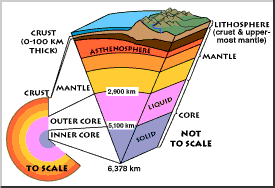Lesson 1 – The objectives of this lesson our to
- Understand and evaluate the cause and consequences of the Japanese Tsunami in 2011
- Describe the structure of the Earth and causes of earthquakes.
The Earth’s Surface is split into roughly 15 different pieces. These are called Plates. Plate tectonics involves how these plates are made, moved and destroyed and particularly interested in the interactions at the boundaries or margins (edges) of these plates. The following picture shows plate tectonics map of the world
Roughly 220 million years ago these plates were all joined together to make one giant continent called Pangea. Over time these plates have been pulled and pushed apart due to convection currents in the earth’s liquid mantle.
The Earths structure.
Earth’s core is roughly 6000 degree due to a combination of residual collision energy from when earth was formed and radioactive decay, caused by unstable isotopes. The core is mostly heavy iron and nickel. Mantle is the thickest layer of the earth and between 3000-1000 degrees roughly. This layer of the earth is Liquid. The upper mantle is called the Asthenosphere and is semi molten. This means that as the liquid flows there is friction between the lithosphere which pulls and pushes the plates. Crust or Lithosphere is the solid skin on the earth. This is the solid rock layer we live on and is made up of oceanic and continental crust. The crust is the coolest, least dense and lightest layer of the Earth.
This short video explains convection currents.
Japanese Tsunami
On Friday 11 March 2011 at 2:46pm local time, an 8.9 magnitude earthquake struck close to the north east coast of Japan approximately 250 miles from Tokyo. The quake triggered a huge tsunami which swept inland near the city of Sendai in Miyagi prefecture.
https://www.youtube.com/watch?t=17&v=5-zfCBCq-8I
The following website provides a detailed overview of the event

